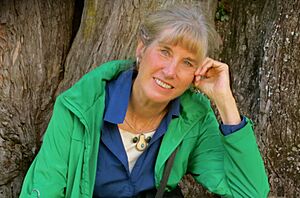Sarah Blaffer Hrdy facts for kids
Quick facts for kids
Sarah Hrdy
|
|
|---|---|
 |
|
| Born |
Sarah Blaffer
July 11, 1946 |
| Nationality | American |
| Alma mater | Radcliffe College (BA) Harvard University (PhD) |
| Awards | Lifetime Career Award, Human Behavior and Evolution Society |
| Scientific career | |
| Fields | Anthropology and primatology |
| Institutions | University of California, Davis |
| Doctoral advisor | Irven DeVore |
Sarah Hrdy (born Sarah Blaffer on July 11, 1946) is an American anthropologist and primatologist. A primatologist is a scientist who studies monkeys and apes. She is famous for her important ideas about evolutionary psychology and sociobiology (the study of how evolution shapes social behavior).
Hrdy is known for helping people understand why female animals, including humans, behave the way they do. She is a Professor Emerita (a retired professor who keeps her title) at the University of California, Davis. In 2002, Discover magazine named her one of the 50 most important women in science.
Contents
Early Life and Education
Sarah Blaffer was born in Dallas, Texas. She grew up in Houston and went to high school at St. John's School and later a school in Maryland.
After high school, she went to Wellesley College and then transferred to Radcliffe College, which was part of Harvard University. She studied anthropology and graduated with the highest honors in 1969.
At first, Hrdy wanted to make films about public health. But she was inspired by a lecture about overpopulation. The lecture reminded her of something a professor, Irven DeVore, had said. He talked about a type of monkey in India called langurs. Among these monkeys, males would sometimes kill infants. Hrdy wanted to find out why.
She went back to Harvard for graduate school in 1970 to study primate behavior. She worked with famous scientists like Irven DeVore, Robert L. Trivers, and E. O. Wilson. She earned her Ph.D. in Anthropology in 1975.
Personal Life
Sarah met Daniel Hrdy at Harvard. They got married in 1972 in Kathmandu, Nepal. They have three children. Today, Sarah Hrdy and her husband live in northern California. They run a walnut farm and work on restoring natural habitats.
Scientific Discoveries
Why Do Langur Monkeys Harm Infants?
When Sarah Hrdy first went to Mount Abu in India, she wanted to study langur monkeys. She had heard that male langurs killed infants because their living spaces were too crowded.
However, she soon realized this idea was wrong. She observed that infants were only attacked when new males from outside the group took over. This led her to a new idea called the "sexual selection hypothesis."
Here's how it works:
- A mother langur who is nursing an infant won't become pregnant again for about a year.
- When a new male takes over a group, he has a short time to have his own babies.
- By killing infants that were fathered by other males, the new male causes the mothers to be ready to have babies again much sooner.
- This allows the new male to pass on his own genes.
Hrdy also noticed that female langurs had their own strategies. To protect their future babies, females would sometimes mate with males who might take over their group later. This way, a male wouldn't be sure if an infant was his or not, making him less likely to harm it.
Her ideas were very controversial at first. Many scientists believed animals always acted for the good of the whole group. But Hrdy showed that individuals often act to improve their own chances of having offspring. Today, her research is widely accepted.
The Importance of Mothers and Helpers
In her 1999 book, Mother Nature, Hrdy studied the relationship between mothers and infants. She explained that being a mother involves making difficult choices. She argued that the "maternal instinct" isn't automatic. Instead, it develops based on the mother's situation and the baby's needs.
Hrdy also stressed that human mothers have always needed help to raise their children. She used the term "allomother" to describe anyone other than the mother who helps care for an infant. An allomother could be a father, a grandparent, an older sibling, or even an unrelated friend or nanny. This idea is called the "Cooperative Breeding Hypothesis."
In her 2009 book, Mothers and Others, she explored how being raised by many helpers affected human evolution. She suggested that because human babies had to get the attention of multiple caregivers, they developed special social and emotional skills. This helped them understand what others were thinking and feeling, a key part of what makes us human.
Because of her research, Hrdy believes that affordable child care is very important for families and society.
Books and Awards
Sarah Hrdy has written several important books, including:
- The Langurs of Abu: Female and Male Strategies of Reproduction (1977)
- The Woman That Never Evolved (1981)
- Mother Nature: A history of mothers, infants, and natural selection (1999)
- Mothers and Others: The evolutionary origins of mutual understanding (2009)
She has received many awards for her work. Some of the most notable include:
- Election to the National Academy of Sciences (1990)
- Howells Prize for Outstanding Contributions to Biological Anthropology (2001)
- HBES Lifetime Career Award for Distinguished Scientific Contribution (2013)
- NAS Award for Scientific Reviewing (2014)

